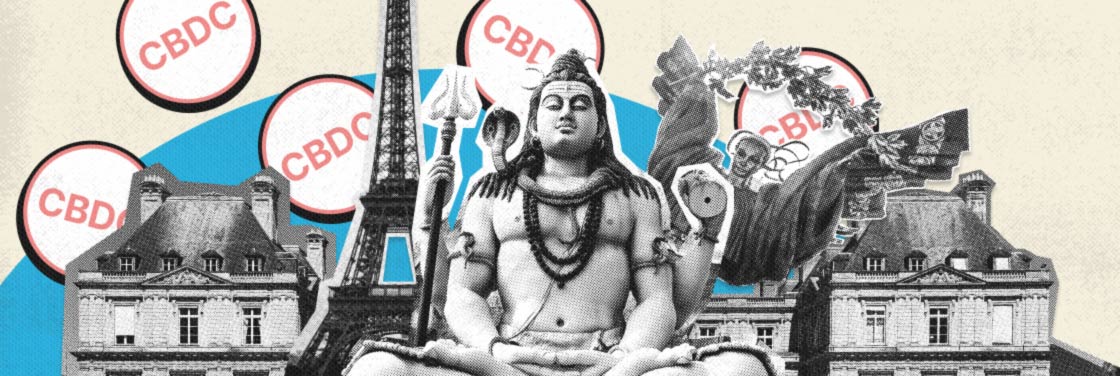India is launching a pilot project of retail CBDC, which will soon be accessible to about 55 million people. The National Bank of Ukraine has developed three possible options for the future e-hryvnia. France and Luxembourg are experimenting with the state digital currency as part of bond redemptions.

France, Luxembourg, India, and Ukraine announced their plans and successes in developing a central bank digital currency (CBDC).
France and Luxembourg
The Bank of France (BF), together with the Central Bank of Luxembourg (BCL), participated in the Venus initiative, which aims to test an experimental central bank digital currency (CBDC) in the form of a tokenized euro. As part of the initiative, the central banks helped the European Investment Bank (EIB) issue €100 million worth of digital bonds.
The bonds issued in this way will be distributed and tested with the participation of Goldman Sachs Bank Europe S.E., Santander, and Societe Generale. The EIB digital bonds were created using distributed ledger technology (DLT) and are fully backed by fiat funds from BCL and BF reserves. For this purpose, the French and Luxembourg Central Banks issued CBDC tokens in a DLT test environment and used them as collateral.
According to Nathalie Aufauvre, Director General for Financial Stability and Operations at the Banque de France, the participation of the two central banks proved that public digital assets “can be issued, distributed and settled in the Eurozone in one day.” Aufauvre is also confident that “a well-designed CBDC can play a crucial role in developing a secure tokenized financial asset space in Europe.”
Recall that the ECB plans to launch a pilot project of the digital euro next year, and in the development of a prototype of the EU digital currency is involved American e-commerce platform Amazon.
Ukraine
The National Bank of Ukraine (NBU) presented the future state digital currency (e-hryvnia) and invited representatives of banking institutions, as well as non-banking financial organizations and virtual asset market in the country, to participate in the discussion of possible variants of the future CBDC.
For instance, the concept of the e-hryvnia being developed by the NBU currently has three different uses:
- For retail non-cash payments. In this case, the primary purpose of the e-hryvnia is the possibility of creating “programmable” money, which can be used primarily for social benefits. This CBDC design option will reduce government administration costs and control the intended use of funds.
- For cross-border payments. In this case, CBDC will ensure the transparency of international payments by increasing the speed of transfers and reducing transaction costs.
- For the use of virtual assets in circulation. This design option implies using CBDC for exchanges, issuance support, and other operations related to digital assets in the country. The E-hryvnia, in this case, may become an essential element for developing the infrastructure of virtual assets in the country.
Oleksii Shaban, Deputy Governor of the NBU, believes that the development and implementation of CBDC can contribute to the evolution of the payment infrastructure and digitalization of the Ukrainian economy. According to him, in October this year, the National Bank received a patent for the trademark “e-hryvnia.”
Recall that Ukraine is in first place in the ranking of countries with the highest crypto adoption rate in 2022. Moreover, the state of the country’s cryptocurrency market was previously reported by local CoinsPaid Media employees.
India
The Reserve Bank of India (RBI) announced the launch of the central bank’s retail digital currency pilot on December 1, 2022.
Retail payment trials using CBDC will take place in 13 cities across the country with a total population of about 55 million people:
- New Delhi (~17 million);
- Mumbai (~11 million);
- Bangalore (~8.5 million);
- Ahmedabad (~5.6 million);
- Hyderabad (~3.6 million);
- Lucknow (~2.9 million);
- Indore (~2 million);
- Patna (~1.4 million);
- Guwahati (~970 thousand);
- Bhubaneswar (~885 thousand);
- Kochi (~600 thousand);
- Shimla (~390 thousand);
- Gangtok (~98 thousand).
Eight banks will participate in the digital rupee test:
- State Bank of India (SBI);
- Yes Bank;
- ICICI Bank;
- IDFC First Bank;
- Bank of Baroda;
- Union Bank of India (UBI);
- HDFC Bank;
- Kotak Mahindra Bank.
Consumers will be able to use the digital rupee to pay for goods and services from selected merchants. This will require scanning a QR code and transferring through a digital wallet.
As a quick reminder, the RBI announced its plans to launch the pilot project of the digital rupee in October this year, having checked the concept in advance for feasibility and functionality.









